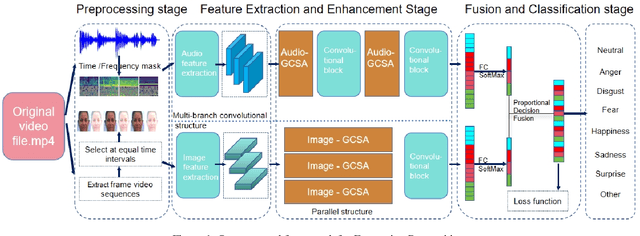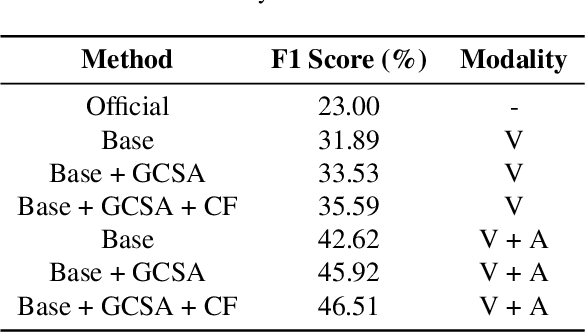Yang Zheng
Breaking Thought Patterns: A Multi-Dimensional Reasoning Framework for LLMs
Jun 16, 2025Abstract:Large language models (LLMs) are often constrained by rigid reasoning processes, limiting their ability to generate creative and diverse responses. To address this, a novel framework called LADDER is proposed, combining Chain-of-Thought (CoT) reasoning, Mixture of Experts (MoE) models, and multi-dimensional up/down-sampling strategies which breaks the limitations of traditional LLMs. First, CoT reasoning guides the model through multi-step logical reasoning, expanding the semantic space and breaking the rigidity of thought. Next, MoE distributes the reasoning tasks across multiple expert modules, each focusing on specific sub-tasks. Finally, dimensionality reduction maps the reasoning outputs back to a lower-dimensional semantic space, yielding more precise and creative responses. Extensive experiments across multiple tasks demonstrate that LADDER significantly improves task completion, creativity, and fluency, generating innovative and coherent responses that outperform traditional models. Ablation studies reveal the critical roles of CoT and MoE in enhancing reasoning abilities and creative output. This work contributes to the development of more flexible and creative LLMs, capable of addressing complex and novel tasks.
Combining Self-attention and Dilation Convolutional for Semantic Segmentation of Coal Maceral Groups
Jun 15, 2025Abstract:The segmentation of coal maceral groups can be described as a semantic segmentation process of coal maceral group images, which is of great significance for studying the chemical properties of coal. Generally, existing semantic segmentation models of coal maceral groups use the method of stacking parameters to achieve higher accuracy. It leads to increased computational requirements and impacts model training efficiency. At the same time, due to the professionalism and diversity of coal maceral group images sampling, obtaining the number of samples for model training requires a long time and professional personnel operation. To address these issues, We have innovatively developed an IoT-based DA-VIT parallel network model. By utilizing this model, we can continuously broaden the dataset through IoT and achieving sustained improvement in the accuracy of coal maceral groups segmentation. Besides, we decouple the parallel network from the backbone network to ensure the normal using of the backbone network during model data updates. Secondly, DCSA mechanism of DA-VIT is introduced to enhance the local feature information of coal microscopic images. This DCSA can decompose the large kernels of convolutional attention into multiple scales and reduce 81.18% of parameters.Finally, we performed the contrast experiment and ablation experiment between DA-VIT and state-of-the-art methods at lots of evaluation metrics. Experimental results show that DA-VIT-Base achieves 92.14% pixel accuracy and 63.18% mIoU. Params and FLOPs of DA-VIT-Tiny are 4.95M and 8.99G, respectively. All of the evaluation metrics of the proposed DA-VIT are better than other state-of-the-art methods.
AllTracker: Efficient Dense Point Tracking at High Resolution
Jun 08, 2025Abstract:We introduce AllTracker: a model that estimates long-range point tracks by way of estimating the flow field between a query frame and every other frame of a video. Unlike existing point tracking methods, our approach delivers high-resolution and dense (all-pixel) correspondence fields, which can be visualized as flow maps. Unlike existing optical flow methods, our approach corresponds one frame to hundreds of subsequent frames, rather than just the next frame. We develop a new architecture for this task, blending techniques from existing work in optical flow and point tracking: the model performs iterative inference on low-resolution grids of correspondence estimates, propagating information spatially via 2D convolution layers, and propagating information temporally via pixel-aligned attention layers. The model is fast and parameter-efficient (16 million parameters), and delivers state-of-the-art point tracking accuracy at high resolution (i.e., tracking 768x1024 pixels, on a 40G GPU). A benefit of our design is that we can train on a wider set of datasets, and we find that doing so is crucial for top performance. We provide an extensive ablation study on our architecture details and training recipe, making it clear which details matter most. Our code and model weights are available at https://alltracker.github.io .
Integrating Intermediate Layer Optimization and Projected Gradient Descent for Solving Inverse Problems with Diffusion Models
May 28, 2025Abstract:Inverse problems (IPs) involve reconstructing signals from noisy observations. Recently, diffusion models (DMs) have emerged as a powerful framework for solving IPs, achieving remarkable reconstruction performance. However, existing DM-based methods frequently encounter issues such as heavy computational demands and suboptimal convergence. In this work, building upon the idea of the recent work DMPlug, we propose two novel methods, DMILO and DMILO-PGD, to address these challenges. Our first method, DMILO, employs intermediate layer optimization (ILO) to alleviate the memory burden inherent in DMPlug. Additionally, by introducing sparse deviations, we expand the range of DMs, enabling the exploration of underlying signals that may lie outside the range of the diffusion model. We further propose DMILO-PGD, which integrates ILO with projected gradient descent (PGD), thereby reducing the risk of suboptimal convergence. We provide an intuitive theoretical analysis of our approaches under appropriate conditions and validate their superiority through extensive experiments on diverse image datasets, encompassing both linear and nonlinear IPs. Our results demonstrate significant performance gains over state-of-the-art methods, highlighting the effectiveness of DMILO and DMILO-PGD in addressing common challenges in DM-based IP solvers.
Interspatial Attention for Efficient 4D Human Video Generation
May 21, 2025Abstract:Generating photorealistic videos of digital humans in a controllable manner is crucial for a plethora of applications. Existing approaches either build on methods that employ template-based 3D representations or emerging video generation models but suffer from poor quality or limited consistency and identity preservation when generating individual or multiple digital humans. In this paper, we introduce a new interspatial attention (ISA) mechanism as a scalable building block for modern diffusion transformer (DiT)--based video generation models. ISA is a new type of cross attention that uses relative positional encodings tailored for the generation of human videos. Leveraging a custom-developed video variation autoencoder, we train a latent ISA-based diffusion model on a large corpus of video data. Our model achieves state-of-the-art performance for 4D human video synthesis, demonstrating remarkable motion consistency and identity preservation while providing precise control of the camera and body poses. Our code and model are publicly released at https://dsaurus.github.io/isa4d/.
Model-free Online Learning for the Kalman Filter: Forgetting Factor and Logarithmic Regret
May 13, 2025Abstract:We consider the problem of online prediction for an unknown, non-explosive linear stochastic system. With a known system model, the optimal predictor is the celebrated Kalman filter. In the case of unknown systems, existing approaches based on recursive least squares and its variants may suffer from degraded performance due to the highly imbalanced nature of the regression model. This imbalance can easily lead to overfitting and thus degrade prediction accuracy. We tackle this problem by injecting an inductive bias into the regression model via {exponential forgetting}. While exponential forgetting is a common wisdom in online learning, it is typically used for re-weighting data. In contrast, our approach focuses on balancing the regression model. This achieves a better trade-off between {regression} and {regularization errors}, and simultaneously reduces the {accumulation error}. With new proof techniques, we also provide a sharper logarithmic regret bound of $O(\log^3 N)$, where $N$ is the number of observations.
Design of an Expression Recognition Solution Employing the Global Channel-Spatial Attention Mechanism
Mar 15, 2025

Abstract:Facial expression recognition is a challenging classification task with broad application prospects in the field of human - computer interaction. This paper aims to introduce the methods of our upcoming 8th Affective Behavior Analysis in the Wild (ABAW) competition to be held at CVPR2025. To address issues such as low recognition accuracy caused by subtle expression changes and multi - scales in facial expression recognition in videos, we propose global channel - spatial attention and median - enhanced spatial - channel attention to strengthen feature processing for speech and images respectively. Secondly, to fully utilize the complementarity between the speech and facial expression modalities, a speech - and - facial - expression key - frame alignment technique is adopted to calculate the weights of speech and facial expressions. These weights are input into the feature fusion layer for multi - scale dilated fusion, which effectively improves the recognition rate of facial expression recognition. In the facial expression recognition task of the 6th ABAW competition, our method achieved excellent results on the official validation set, which fully demonstrates the effectiveness and competitiveness of the proposed method.
Solution for 8th Competition on Affective & Behavior Analysis in-the-wild
Mar 14, 2025Abstract:In this report, we present our solution for the Action Unit (AU) Detection Challenge, in 8th Competition on Affective Behavior Analysis in-the-wild. In order to achieve robust and accurate classification of facial action unit in the wild environment, we introduce an innovative method that leverages audio-visual multimodal data. Our method employs ConvNeXt as the image encoder and uses Whisper to extract Mel spectrogram features. For these features, we utilize a Transformer encoder-based feature fusion module to integrate the affective information embedded in audio and image features. This ensures the provision of rich high-dimensional feature representations for the subsequent multilayer perceptron (MLP) trained on the Aff-Wild2 dataset, enhancing the accuracy of AU detection.
Dual-Stage Cross-Modal Network with Dynamic Feature Fusion for Emotional Mimicry Intensity Estimation
Mar 13, 2025Abstract:Emotional Mimicry Intensity (EMI) estimation serves as a critical technology for understanding human social behavior and enhancing human-computer interaction experiences, where the core challenge lies in dynamic correlation modeling and robust fusion of multimodal temporal signals. To address the limitations of existing methods in insufficient exploitation of modal synergistic effects, noise sensitivity, and limited fine-grained alignment capabilities, this paper proposes a dual-stage cross-modal alignment framework. First, we construct vision-text and audio-text contrastive learning networks based on an improved CLIP architecture, achieving preliminary alignment in the feature space through modality-decoupled pre-training. Subsequently, we design a temporal-aware dynamic fusion module that combines Temporal Convolutional Networks (TCN) and gated bidirectional LSTM to respectively capture the macro-evolution patterns of facial expressions and local dynamics of acoustic features. Innovatively, we introduce a quality-guided modality fusion strategy that enables modality compensation under occlusion and noisy scenarios through differentiable weight allocation. Experimental results on the Hume-Vidmimic2 dataset demonstrate that our method achieves an average Pearson correlation coefficient of 0.35 across six emotion dimensions, outperforming the best baseline by 40\%. Ablation studies further validate the effectiveness of the dual-stage training strategy and dynamic fusion mechanism, providing a novel technical pathway for fine-grained emotion analysis in open environments.
Interactive Multimodal Fusion with Temporal Modeling
Mar 13, 2025Abstract:This paper presents our method for the estimation of valence-arousal (VA) in the 8th Affective Behavior Analysis in-the-Wild (ABAW) competition. Our approach integrates visual and audio information through a multimodal framework. The visual branch uses a pre-trained ResNet model to extract spatial features from facial images. The audio branches employ pre-trained VGG models to extract VGGish and LogMel features from speech signals. These features undergo temporal modeling using Temporal Convolutional Networks (TCNs). We then apply cross-modal attention mechanisms, where visual features interact with audio features through query-key-value attention structures. Finally, the features are concatenated and passed through a regression layer to predict valence and arousal. Our method achieves competitive performance on the Aff-Wild2 dataset, demonstrating effective multimodal fusion for VA estimation in-the-wild.
 Add to Chrome
Add to Chrome Add to Firefox
Add to Firefox Add to Edge
Add to Edge